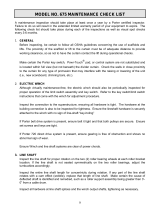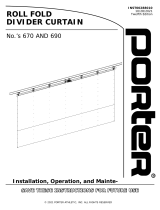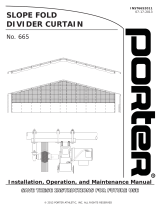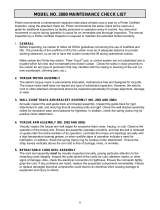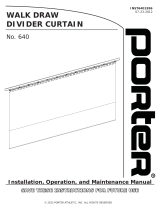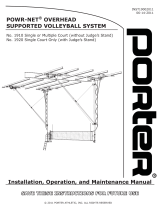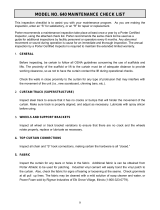Page is loading ...

9
MODEL NO. 670 AND 690 MAINTENANCE CHECK LIST
Porter recommends a maintenance inspection take place at least once a year by a Porter Certified
Inspector, using the attached check list. Porter recommends the same check list be used as a
guide for additional inspections by facility personnel or operators every 6 months. Any abnormal
movement or sound during operation is cause for an immediate and thorough inspection. The annual
inspection by a Porter Certified Inspector is required to maintain the extended limited warranty.
1. GENERAL
Before inspecting, be certain to follow all OSHA guidelines concerning the use of scaffolds and
lifts. The proximity of the scaffold or lift to the curtain must be of adequate distance to provide
working clearance, so as not to have the curtain contact the lift during operational checks.
Make certain the Porter key switch, Powr-Touch® pad, or control system are not substituted and
is located within full view (but not beneath) the divider curtain. Check the walls in close proximity
to the curtain for any type of protrusion that may interfere with the raising or lowering of the unit
(i.e., new scoreboard, chinning bars, etc.).
2. ELECTRIC WINCH
Although virtually maintenance-free, the electric winch should also be periodically inspected for
proper operation of the limit switch assembly and key switch. Refer to the key switch/limit switch
instructions that come with the winch for adjustment procedure.
Inspect the connection to the superstructure, ensuring all hardware is tight. The hardware at the
building connection is also to be inspected for tightness. Ensure the lineshaft hardware is securely
attached to the winch with no sign of line-shaft “key-holing”
If Porter belt drive system is present, ensure belt it tight and that both pulleys are secure. Ensure
set screws and keys are tight.
If Porter 720 direct drive system is present, ensure gearing is free of obstruction and shows no
abnormal sign of wear.
Ensure Winch and line shaft systems are clear of power chords.
3. LINE SHAFT
Inspect the line shaft for proper rotation on the two (2) roller bearing wheels at each roller bracket
location. If the line shaft is not seated symmetrically on the two roller bearings, adjust the
turnbuckles accordingly.
Inspect the entire line shaft length for concentricity during rotation. If any part of the line shaft
rotates with a cam effect (wobble), replace that length of line shaft. Make certain the cause of
deflected shaft is identified and remedied, such as a roller support assembly being greater then 3’-
0” from a cable drum.
Inspect all hardware at line shaft splices and the winch output shafts, tightening as necessary.

10
4. LINE SHAFT SUPPORTS
All support fittings, shaft and pipe splices, support rods, etc. should be inspected for fatigue
cracks, loose bolts or set screws, and corrosion, on an annual basis. Replace defective parts as
required.
5. ROLLER BRACKET SUPPORTS AND TOP CURTAIN CONNECTIONS
Inspect all turnbuckles and “S” hook connections, making certain the hardware is all “closed”.
Alignment of the roller assembly is to be inspected for a smooth rotation of the line shaft.
6. HOISTING CABLES
Inspect all 1/8” galvanized hoisting cables for kinking or fraying, replacing as necessary.
7. CABLE DRUMS
Make certain all cable drums are secured with two (2) 5/16” x 7/16” lg. rivets or self drilling screw,
and not just a set screw. All cable must be within the side drum plates. If any cable is winding
outside the drum on the line shaft, this is an indication of an incorrect up or down limit switch
adjustment. Refer to the limit switch section of this manual for adjustment procedure. Adjust so
that the cable has minimum build up on itself through the travel of the curtain by adjusting the
location.
8. TOP AND BOTTOM CURTAIN POCKET CONCEALED PIPES
Inspect both the top and bottom pockets, ensuring the concealed pipe is not separating. At the
bottom hem, the pipe is to be secured to the fabric at each cable line with a 5/16” bolt through the
curtain, the bottom pipe, and secured with a cap nut (see Figure O). If padded bottom tube is
present, confirm padding does not need replaced.
9. SUPERSTRUCTURE
Visually inspect all super structure and connections for any sign of abnormal deflection or
structural cracks. Check all hardware to confirm it is present and secure.
10. FABRIC
Inspect the curtain for any tears or holes in the fabric. Additional fabric can be obtained through
Porter Athletic, to be used for patching. Industrial vinyl cement will easily bond the vinyl patch to
the curtain. Also, check the fabric for signs of tearing or loosening at the seams. Check grommets
at all pullup lines. The fabric may be cleaned with a mild solution of soap cleaner and water, or
Power Foam sold by Rigmar Industries of Elk Grove Village, Illinois (1-800-323-0779).
11. UNIVERSAL JOINTS (690 CURTAIN ONLY)
Check that each universal joint is properly free to allow for proper transferring of the rotation of the
line shaft. Lubricate if necessary. Ensure all hardware is secure.

11
670 or 690 DIVIDER CURTAIN INSPECTION REPORT
The following page should be copied and returned to Porter Athletic by a Porter Certified Inspector after
each inspection.
Porter Order Number _________________________
Project Name _________________________
Name of Selling Dealer _________________________
Date of Scheduled Shipment _________________________
Date of Substantial Completion _________________________
(Information should be found on the first page of Installation manual)
Inspecting Company Name ___________________________________________
Porter Certified Inspector Name ____________________________________________
Inspection Date ____________________________________________
Summary of Inspected Equipment, Include any replaced, repaired, damaged, or worn
parts.___________________________________________________________________
_______________________________________________________________________
_______________________________________________________________________
_______________________________________________________________________
_______________________________________________________________________
_______________________________________________________________________
_______________________________________________________________________
_______________________________________________________________________
_______________________________________________________________________
_______________________________________________________________________
_______________________________________________________________________
_______________________________________________________________________
_______________________________________________________________________
Please attach the checklist of each equipment inspected

12
670 AND 690 CURTAIN INSPECTION CHECKLIST
Please refer to previous pages for details on inspections.
This checklist is to assist you in your inspection program.
As you are making the inspection, enter “S” for satisfactory, or “R” for repair and replace.
INSPECT ALL ITEMS FOR EACH CURTAIN
ELECTRIC WINCH
#1 #2 #3 #4 #5 #6 #7 #8 #9 #10 #11 #12
LINESHAFT
#1 #2 #3 #4 #5 #6 #7 #8 #9 #10 #11 #12
LINESHAFT SUPPORTS
#1 #2 #3 #4 #5 #6 #7 #8 #9 #10 #11 #12
ROLLER BRACKET SUPPORTS AND TOP CURTAIN CONNECTIONS
#1 #2 #3 #4 #5 #6 #7 #8 #9 #10 #11 #12
HOISTING CABLES
#1 #2 #3 #4 #5 #6 #7 #8 #9 #10 #11 #12
CABLE DRUMS
#1 #2 #3 #4 #5 #6 #7 #8 #9 #10 #11 #12
TOP AND BOTTOM POCKET CONCEALED PIPES
#1 #2 #3 #4 #5 #6 #7 #8 #9 #10 #11 #12
STRUCTURE
#1 #2 #3 #4 #5 #6 #7 #8 #9 #10 #11 #12
FABRIC
#1 #2 #3 #4 #5 #6 #7 #8 #9 #10 #11 #12
UNVIERSAL JOINTS (690 CURTAIN ONLY)
#1 #2 #3 #4 #5 #6 #7 #8 #9 #10 #11 #12
OTHER EQUIPMENT
#1 #2 #3 #4 #5 #6 #7 #8 #9 #10 #11 #12
/
